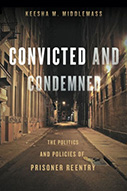Convicted And Condemned: The Politics And Policies Of Prisoner Reentry

Author: Keesha M. Middlemass
Publisher: New York: New York University Press, 2017. 288p.
Reviewer: Bryan L. Sykes | July 2019
At the close of 2016, more than 4.53 million adults were under community supervision in America, with almost 156,000 men and women on probation or parole in New Jersey alone (Kaeble 2018). As the movement for decarceration — the reduced use of incarceration or the depopulation of correctional facilities — gathers steam across the U.S., fundamental questions remain as to whether people who were once locked away in jails and prisons are now subject to the prolonged, formal monitoring under community supervision programs. These programs make reentry their central focus; however, it is unclear how people subject to the gaze of criminal justice system transition back into society. Keesha Middlemass’ book sheds light on this process.
Drawing on twenty-nine months of ethnographic and participant observations, in-depth interviews, and archival research at a reentry non-profit organization in Newark, New Jersey, Middlemass argues that “a felony conviction is a socially constructed lived experience that extends the past into the future,” (p.5) and, in doing so, renders men and women with felony records socially disabled. By drawing an analogy between the stigma of a felony record and the social model of disability, Middlemass suggests that both are socially constructed but that society has put in place accommodations for people in the latter classification but not the former. In making this comparison, Convicted and Condemned points to the fact that the law transforms people with felony records into contemporary outlaws through socially disabling policies that restrict benefits and citizenship rights, forcing felons to live in the “gray area” — the liminal space and time between leaving prison and reentering society (p. 27).
Middlemass interviews fifty-three men and women as they reenter society. Many of her participants served sentences from thirty days to fifty years. Although much of the research for Convicted and Condemned focused on ethnographic and participant-observations, the in-depth interviews enabled the author to examine facets of social disability (i.e., the inability to obtain housing, employment, or educational assistance). Furthermore, Middlemass draws on archival research to verify and validate details of her participants’ stories (criminal charges, length of sentence, parole status, and age), although it is not always clear where and when this research mattered for recontextualizing the particular narratives of men and women reentering society.
While I am swayed by Middlemass’ argument and data, several topics in the book gave me pause. For instance, in Chapter 4 the author discusses the history and role of Pell Grants in prison education programs. In retelling the story of how federal and state politicians eliminated or significantly reduced funding for prison educational programs during the 1990s, the author does not mention that the educational financing landscape has shifted during an era of decarceration. Middlemass writes, “One of those policy changes extended a blanket felony conviction clause to ensure that felons living in the community were ineligible to access Pell grants upon the completion of their criminal sentence,” (p. 118). However, current U.S. Department of Education (2018) rules state that non-institutionalized people on probation or parole can receive Pell Grants if they were not convicted of drug-related or various types of sexual offenses (particularly those requiring involuntary civil commitment). A similar oversight and omission occurs when discussing whether men and women on probation or parole qualify for other forms of state aid, as recent research routinely points to former inmates relying extensively on economic assistance from the general fund in states like California and Massachusetts (Harris et al. 2017; Western 2018).
Nevertheless, Convicted and Condemned is a solid piece of social science research. Keesha Middlemass has made an important contribution to the field, particularly for documenting the various rehabilitative programs that people reentering society must complete as a condition of their probation or parole, as well as the for illustrating the conflicting nature of various conditions imposed on probationers and parolees (e.g., obtaining employment despite facing discrimination for having a felony record). Convicted and Condemned is a must cite for scholarship on prisoner reentry.
Bryan L. Sykes, University of California-Irvine
References
Harris Alexes, Beth Huebner, Karin Martin, Mary Pattillo, Becky Pettit, Sarah Shannon, Bryan Sykes, and Chris Uggen. 2017. “United States Systems of Justice, Poverty and the Consequences of Non-Payment of Monetary Sanctions: Interviews from California, Georgia, Illinois, Minnesota, Missouri, Texas, New York and Washington.” Washington, D.C.: Laura and John Arnold Foundation. http://www.monetarysanctions.org/wp-content/uploads/2018/01/Monetary-Sanctions-2nd-Year-Report.pdf Last Accessed: October 3, 2018.
Kaeble, Danielle. 2018. Probation and Parole in the United States, 2016. Washington D.C.: Bureau of Justice Statistics.
U.S. Department of Education, Office of Federal Student Aid. 2018. “Students with Criminal Convictions.” https://studentaid.ed.gov/sa/eligibility/criminal-convictions Last Accessed: October 3, 2018.
Western, Bruce. 2018. Homeward: Life in the Year after Prison. New York, NY: Russell Sage Foundation.


